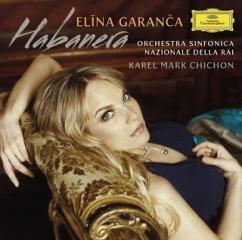Elina Garanca – Habanera (2010)
Elina Garanca – Habanera (2010)

1.- Canción de Paloma (Carmen) 2.- Seguedille et Duo: "Pres des remparts de Seville" 3.- Hor' ich Zymbalklange (The Bohemian Girl) 4.- I dreamt I dwelt in Marble Halls 5.- Canción de cuna para dormir a un negrito 6.- Canción del amor dolido 7.- Nana 8.- Vocalise en Forme de Habanera 9.- Romanza de Socorro "Cunado esta tan honda" (Candide) 10.- I Am Easily Assimilated (Old Lady's Tango) 11.- Canción del amor 12.- Jota 13.- "De España vengo" (Carmen) 14.- Chanson: "Les tringles des sistres tintaient" 15.- El vito 16.- Canción de la gitana (Carmen) 17.- "L'amour est un oiseau rebelle" (Havanaise) 18.- "L'amour est un enfant Boheme" (Havanaise 1st version)
Carmen is one of the roles for which Latvian mezzo-soprano Elina Garanca is best known and in this album, including several selections from the opera, she brings together a diverse assortment of songs and arias with gypsy themes. Most are musically related to gypsy cultures, and the majority are flavored by Spanish or Latin traditions, along with some that are Eastern European, but in "I dreamt I dwelt in marble halls," from Balfe's Bohemian Girl, the gypsy theme is only found in the text. Garanca's voice is warm and pure, but with a sensuality that suits this repertoire beautifully. Her "Seguidilla" (in which she's joined by Roberto Alagna) is especially effective, with an understated seductiveness that entices Don José as much by what it withholds as by what it reveals. That performance and Garanca's nuanced "Habanera" are ample evidence she fully deserves her reputation as a legendary Carmen. She also includes Bizet's original setting of the Habanera text, which the composer replaced with the now-standard version, and which is not a Habanera at all, but a fairly conventional Romantic aria in triple time. It's an interesting relic, but it is testimony to Bizet's good judgment that he recognized its conventionality, because his second thoughts on the text produced a piece that is head and shoulders above his first, both musically and in what it reveals psychologically about Carmen. Garanca shows her versatility by adapting easily to the various vocal styles required by this repertoire, from the full-blown operatic to the breezy popular flavor of a song by virtuoso Spanish guitarist José María Gallardo del Rey, who accompanies her on several tracks. Several of the selections, such as Montsalvatge's "Canción de cuna para dormir a un negrito" and de Falla's "Canción del amor dolido," are most compelling when performed by a singer with a more natural affinity for jazz, but Garanca's delivery is effective on its own terms. Karel Mark Chichon leads Orchestra Sinfonica Nazionale della Rai and Coro Filarmonico del Regio di Torino in thoughtful accompaniment. Deutsche Grammophon's sound is full and well balanced. --- Stephen Eddins, Rovi
download: uploaded anonfiles yandex 4shared solidfiles mediafire mega








